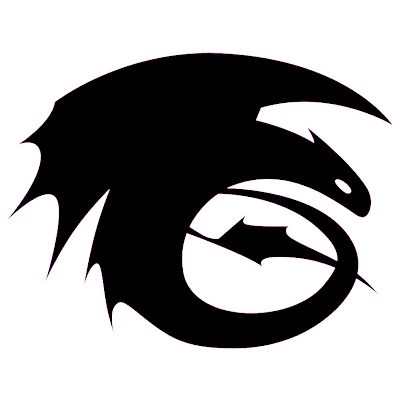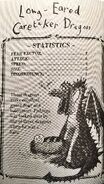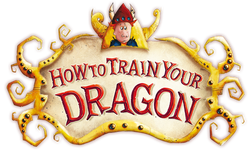No edit summary Tag: sourceedit |
m (Removing Category Dragons (automatic)) |
||
| (10 intermediate revisions by 5 users not shown) | |||
| Line 2: | Line 2: | ||
|Name = Long-Eared Caretaker Dragon |
|Name = Long-Eared Caretaker Dragon |
||
|Image = 577083_358265600902614_756748215_n.jpg |
|Image = 577083_358265600902614_756748215_n.jpg |
||
| − | |Class = Bog Dragon |
+ | |Class = [[Dragon Classes (Books)#Bog Dragons|Bog Dragon]] |
|Features = |
|Features = |
||
|Abilities = |
|Abilities = |
||
| Line 26: | Line 26: | ||
|Size Photo = |
|Size Photo = |
||
|Source = Book}} |
|Source = Book}} |
||
| + | '''Long-Eared Caretaker Dragons''' are a dragon species mentioned in ''[[How to Seize a Dragon's Jewel]]'' and detailed in the reference book, ''[[The Incomplete Book of Dragons]]''. |
||
| + | ==Physical Appearance== |
||
| ⚫ | |||
| ⚫ | Caretaker Dragons have long floppy, cavernous ears, giving the appearance of a basset hound or lop-eared rabbit. These ears do serve a purpose, though. Caretaker Dragon pairs raise and parent their eggs and offspring (unlike some dragon species). After laying several speckled [[Dragon Eggs (Books)|eggs]], the female will place the eggs in the folds of her mate's ears, where the eggs will remain warm and dry until hatching. After hatching, the baby Caretaker Dragons will still use their parent's ears for shelter and protection. |
||
| + | ==Behavior== |
||
| − | ==Traits and Abilities== |
||
| + | Because of the Long-Eared Caretaker Dragon's strong parental instinct and docile nature, they are used to watch over human infants and children, as was the case with orphan [[Fishlegs No-Name|Fishlegs]]. |
||
| ⚫ | Caretaker Dragons have long floppy, cavernous ears, giving the appearance of a basset hound or lop-eared rabbit. These ears do serve a purpose, though. Caretaker Dragon pairs raise and parent their eggs and offspring (unlike some dragon species). After laying several speckled eggs, the female will place the eggs in the folds of her mate's ears, where the eggs will remain warm and dry until hatching. After hatching, the baby Caretaker Dragons will still use their parent's ears for shelter and protection |
||
| + | |||
| + | ==Training== |
||
| ⚫ | |||
| + | |||
| + | ==Appearances== |
||
| ⚫ | |||
| + | A Caretaker Dragon is mentioned as raising Fishlegs on [[Isle of Berk (Books)|Berk]]. |
||
| + | |||
| + | ===''[[The Incomplete Book of Dragons]]''=== |
||
| + | This reference book details some of the biology of the Long-Eared Caretaker Dragon. |
||
==Gallery== |
==Gallery== |
||
| Line 41: | Line 53: | ||
</gallery> |
</gallery> |
||
| − | == |
+ | ==Site Navigation== |
| ⚫ | |||
| ⚫ | |||
| − | *The [[The Complete Book of Dragons: A Guide To Dragon Species]], Cressida Cowell. 2014 |
||
| + | [[Category:Bog Dragon Class]] |
||
| ⚫ | |||
| − | [[Category:Dragons]] |
+ | [[Category:The Incomplete Book of Dragons]] |
| − | [[Category:Book Dragons]] |
+ | [[Category:The Incomplete Book of Dragons - Dragons]] |
| + | [[Category:How to Seize a Dragon's Jewel]] |
||
| + | [[Category:How to Seize a Dragon's Jewel - Dragons]] |
||
| + | [[Category:Dragon Species from the Books]] |
||
Revision as of 09:48, 9 May 2020
Long-Eared Caretaker Dragons are a dragon species mentioned in How to Seize a Dragon's Jewel and detailed in the reference book, The Incomplete Book of Dragons.
Physical Appearance
Caretaker Dragons have long floppy, cavernous ears, giving the appearance of a basset hound or lop-eared rabbit. These ears do serve a purpose, though. Caretaker Dragon pairs raise and parent their eggs and offspring (unlike some dragon species). After laying several speckled eggs, the female will place the eggs in the folds of her mate's ears, where the eggs will remain warm and dry until hatching. After hatching, the baby Caretaker Dragons will still use their parent's ears for shelter and protection.
Behavior
Because of the Long-Eared Caretaker Dragon's strong parental instinct and docile nature, they are used to watch over human infants and children, as was the case with orphan Fishlegs.
Training
Caretaker Dragons are used by Vikings as cart dragons, babysitters, and children's guard dragons. They rate a Disobedience factor of "1", meaning they are very easily trained.
Appearances
How to Seize a Dragon's Jewel
A Caretaker Dragon is mentioned as raising Fishlegs on Berk.
The Incomplete Book of Dragons
This reference book details some of the biology of the Long-Eared Caretaker Dragon.






